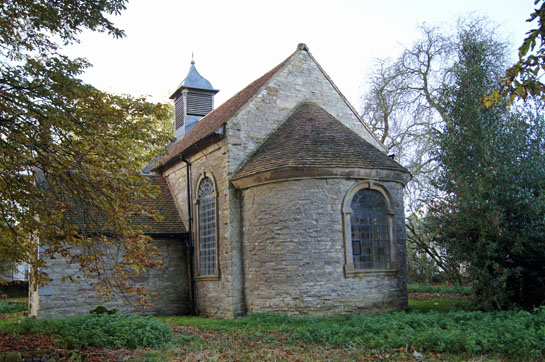|
Alphabetical List |
|
|
|
|
|
|
|
County List and Topics |
|
|
|
Please sign my Guestbook and leave feedback |
|
|
||||||||||||||||||||||
|
immunity during the devastating 1348 pandemic. The church had no rector after 1624 and, unsurprisingly, it fell into decay. Fortunately, in 1692 the new owner of the manor, one Bernard Whalley, decided to have it completely rebuilt. Nobody seems to know the original plan. Perhaps it had an apsidal east end which the new one replaced or perhaps Mr Whalley just had a taste for the Romanesque style. Either way the church he built is an engaging blend of faux Norman structure and Stuart period interior. The windows are round-headed in the Norman style but on a much grander scale and with plain glass. Each has an attractive raised stone surround. The north wall is believed to have some stonework from the original church. There is a south transept or vestry and a west porch through which the church is accessed. It is a surprisingly tasteful and attractive building. It pays tribute to the Norman architectural heritage without falling into the trap of parody - unlike some neo-Norman confections I could mention! The interior is also very engaging. There are family box pews and a minstrel’s gallery, all apparently dating from 1692. Apart from the wall monuments I so love to hate, the walls are as plain as the glass. The overall effect is of an austere solemnity of a previous era. There are no children’s corners, WI banners or war memorials. It is a simple “house of God” that time forgot until the Churches Conservation Trust - gawd bless ‘em - took it under their wing. Let’s turn to the Norman carvings housed within the transept. The most important is an almost complete Norman tympanum that the CCT found amongst the rubble used to block a doorway! This is no ordinary tympanum. It is in the style of the Herefordshire School of Norman architecture and what’s more was certainly carved by the same mason who produced the font at Eardisley a good 65 miles away in Herefordshire and which also seems to have links to Bredwardine Church nearby.There is a fragment of what is believed to be another tympanum with the same harrowing of hell theme as at Eardisley. A lot more about these in the footnote below. |
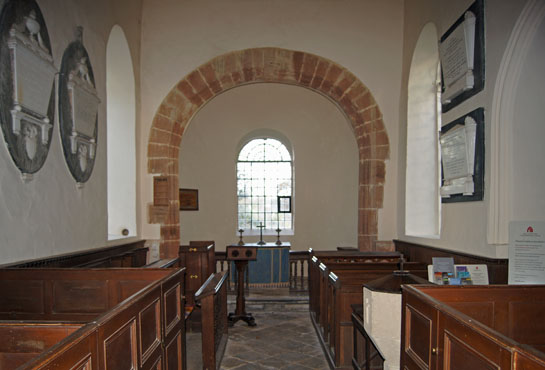 |
|||
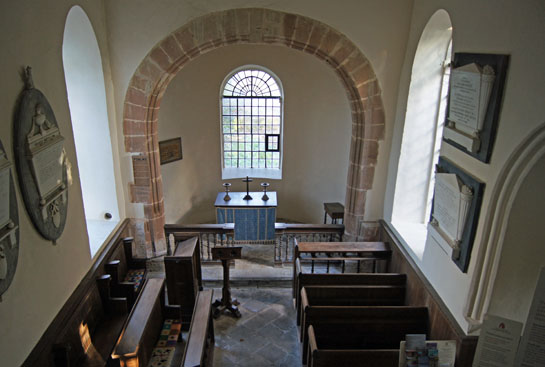 |
|||
|
Two views of the church looking east. The right hand picture is taken from the minstrel’s gallery. Note the apsidal east end and simple chancel arch in the round-headed Romanesque/Norman style. |
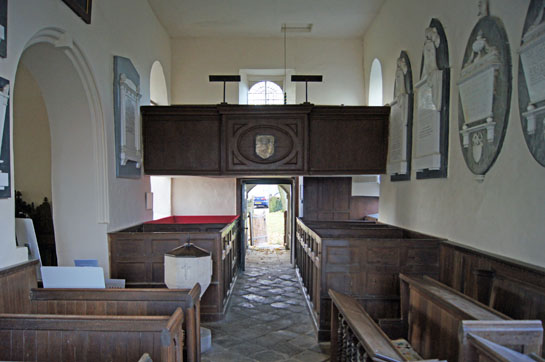 |
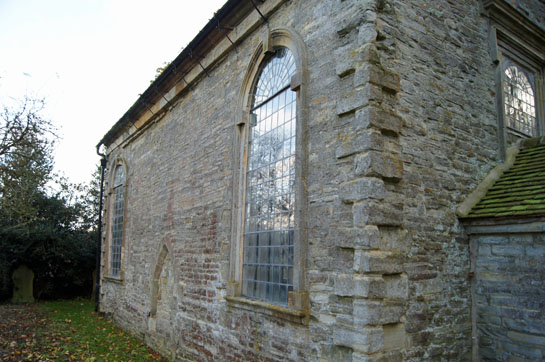 |
||||
|
Left: Looking towards the west end. The gallery is almost comically out of proportion with the rest of the church but I’m sure they were all the rage in 1692! It must be pretty oppressive for those in the pews below! They too date from the 1692 rebuilding. Right: The north side. There is a blocked c14 doorway here which tells us that the 1692 rebuilding did not involve total demolition. Indeed, it has been suggested that some of this wall is the original Norman work. |
|||||
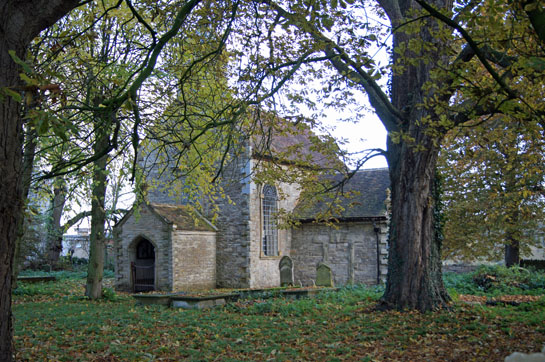 |
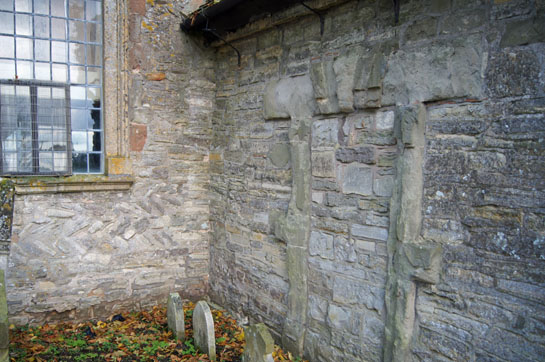 |
||||
|
Left: The church from the south west. The porch was re-sited here by Bernard Whalley so that it faced the manor. Right: Another blocked doorway, this time on the west side of the south transept and dating from the rebuilding. There is or was a Norman carving - part of a harrowing of hell scene - set into this block-work but it is now inside the church. Note the herringbone masonry beneath the window to the left. Such masonry is normally associated with the late Saxon and early Norman eras. Why would someone construct such a masonry course in the c17? This seems to indicate, again, that ancient masonry was retained during the rebuilding and that the original was early Norman if not pre-Norman. |
|||||
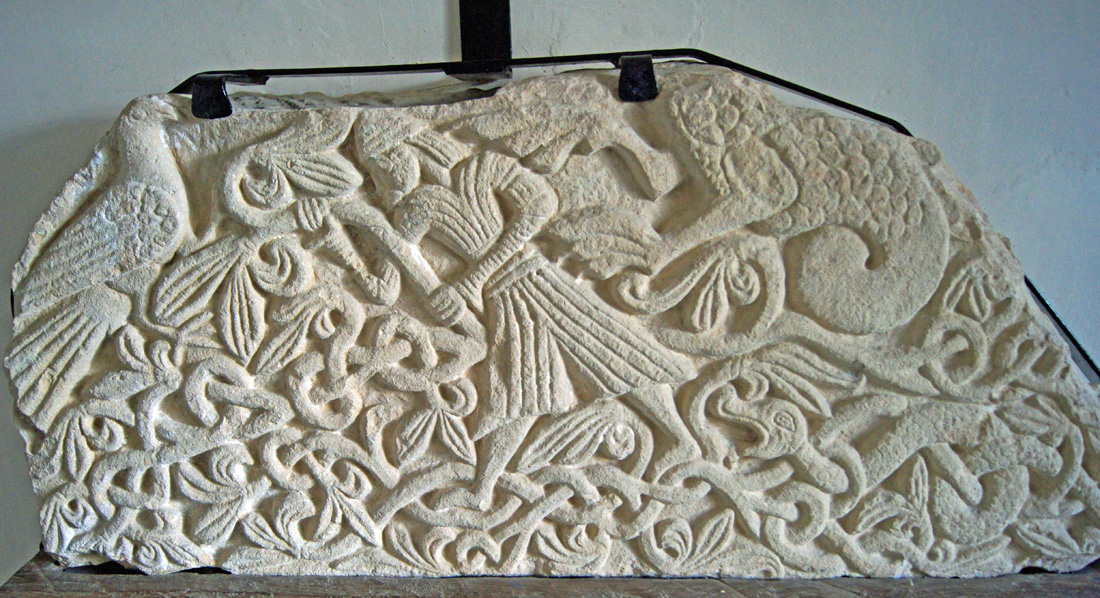 |
|
The reconstructed tympanum really is a stunner. You will see few better pieces of Norman sculpture in England. This is the point at which you must view the font at Eardisley, for it is without any shadow of doubt by the same carver. The representation here is, for once, fairly straightforward: the central figure is running from evil as represented by a dragon and a snake towards purity represented by a dove. Note the incredibly intricate intertwined plant stems. The central human figure, so reminiscent of those at Eardisley. I can’t make out what he is holding. Is he pulling himself along a tree or some other plant? |
||||||||||||
 |
||||||||||||
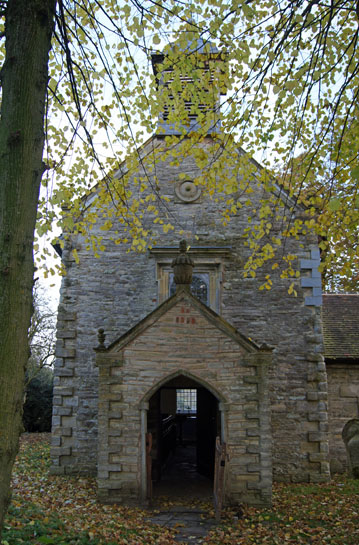 |
||||||||||||
|
Left: I am a bit mystified about this carving carvings. The CCT information board does not discuss it but I believe it is a fragment of a cross shaft. Right: The west end showing the porch its Georgian (?) adornments and the little wooden bell-cote. |
||||||||||||
|
Footnote 1 - The Tympanum Conundrum |
||||||||||||
|
The problem with Billesley is that the comprehensive rebuilding leaves us totally in the dark about what form the original church took. This wonderful tympanum was recovered from rubble in the walls! It seems extraordinary that the same man carved Eardisley font. Eardisley is at the far west of the area within which we find the Herefordshire School of carving. Billesley is at the extreme east. The intervening distance is 65 miles. It’s not an impossible distance even in Norman times. That he was able to do so demonstrates that he was “free” at a time when so many were serfs. How and by whom was he commissioned? Malcolm Thurlby’s definitive book “The Herefordshire School of Romanesque Sculpture” (Logaston Press 1999) specifically tackles this theme and is able to make educated theories for most Herefordshire School sculptures. Eardisley font he attributes squarely to the patronage of Ralph de Baskerville as he does the Romanesque carving at Stretton Sugwas 12 miles to the west of Eardisley. The lands at both those locations were known to have been owned by him. Malcolm, however, does not advance any theories about the Billesley patron. On my own website for Bredwardine in Herefordshire, itself only 5 miles from Eardisley, I hypothesise that the door lintels were moved there from Eardisley when the latter was re-built in around 1200; and one of the facts underpinning that theory was that Bredwardine too was acquired by the de Baskervilles. I can find no historic connection between Billesley and the de Baskervilles. What is also significant is that the CCT believes Billesley to have been built in the eleventh century - that is, it is early Norman. Yet the first church at Eardisley is believed to have been built in 1100 and the font to date from around 1150. It seems clear, therefore, that if all this is true then this tympanum could not have been part of the original Billesley church. It must have been added later in the Norman era. Let’s now throw in the issue of the fragment of a second tympanum at Billesley. Is it by the same sculptor? It seems likely. So where is this leading? Well, the tympanum here would not have looked out of place at Eardisley. I already believe that when Eardisley was rebuilt in 1200 its door lintels were re-used at Bredwardine that had acquired a de Baskerville connection. Billesley has no obvious connection with the de Baskervilles so there are two possibilities. One is that the Eardisley carver had the freedom to travel sixty five miles to carve a tympanum at Billesley for a different patron. Masons were “free” so this is perfectly plausible. Thurlby goes as far as to suggest the that tympana here are the work of the “Chief Mason” of the Herefordshire School. The other is that two tympana were originally carved by that man at Eardisley and moved 65 miles to Billesley perhaps 50 years later when Eardisley was rebuilt. I have seen no discussion of this issue elsewhere or of my theory that door lintels were moved from Eardisley to Bredwardine. The obvious answer is that the church at Billesley needed two new doorways and our man was asked to travel sixty five miles to carve them. Perhaps the de Baskervilles recommended him? But look at that stone. It looks like it is sandstone, the same as that used at Eardisley. What stone is Billesley built from? Blue lias! If Eardisley Man carved here he must have brought his stone with him! Alternatively he might have carved the tympana in Herefordshire and brought them to Billesley as finished products. I feel that it unlikely and the cost of carriage of stone over distance of sixty-odd miles would probably have been prohibitive for a tiny out of the way church. Nor am I aware of any other examples of the Herefordshire School doing this. It is a mystery but I really do think there is a possibility that the two tympana were originally at Eardisley. |
||||||||||||
|
Footnote 2 - The Shakespeare Connection |
||||||||||||
|
Well this is Warwickshire and we (I was born in the county myself) do love a good Shakespeare connection! Billesley is one of a few churches that may have hosted the marriage of Shakespeare and Ann Hathaway. There are no parish records from that period so it is pure speculation. The known linkage with the couple is that William’s granddaughter, Elizabeth, chose to get married there in June 1649. Neither she nor her husband, Sir John Bernard, had any connections with Billesley. Moreover it was by now a tiny village with a decaying church and no permanent rector. So the speculation is that Elizabeth chose to marry here, emulating her celebrated grandfather. |
||||||||||||
